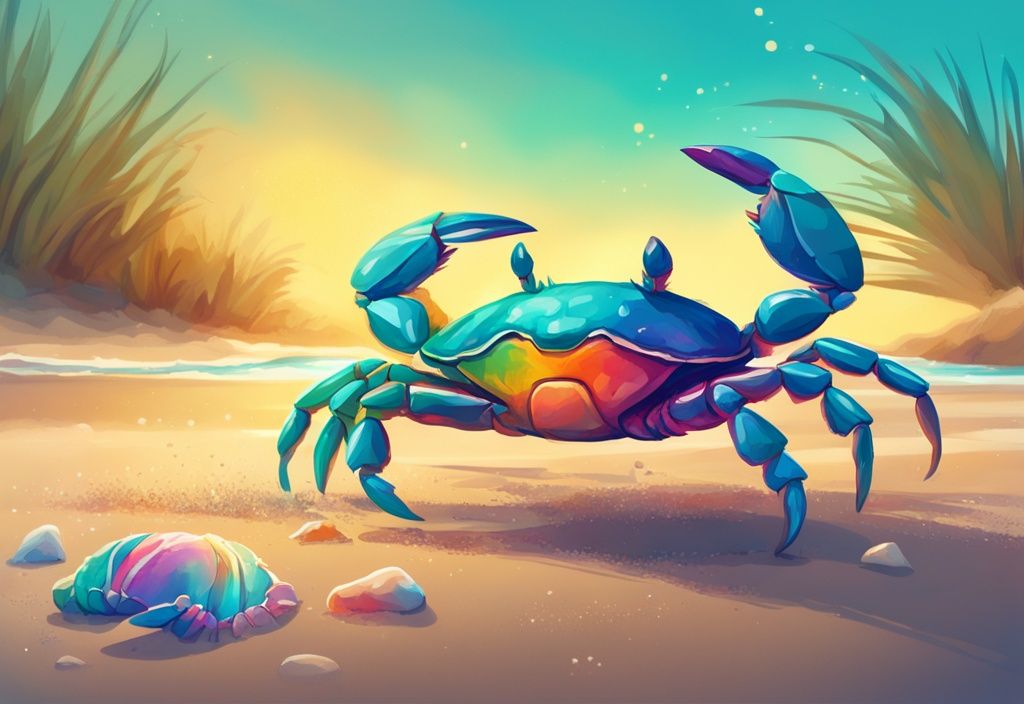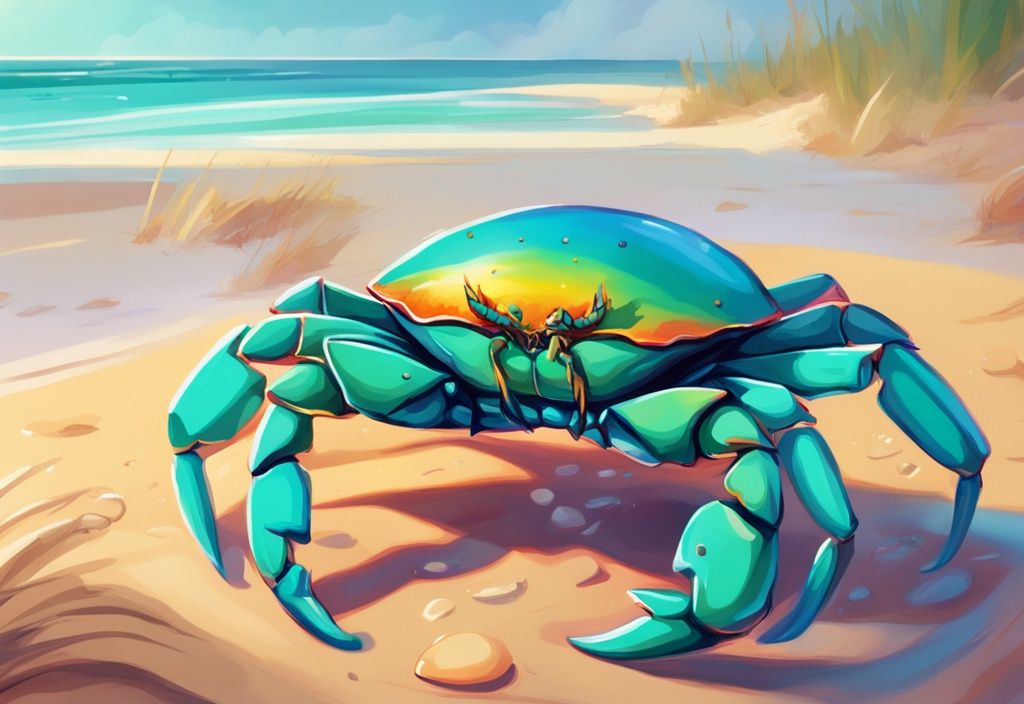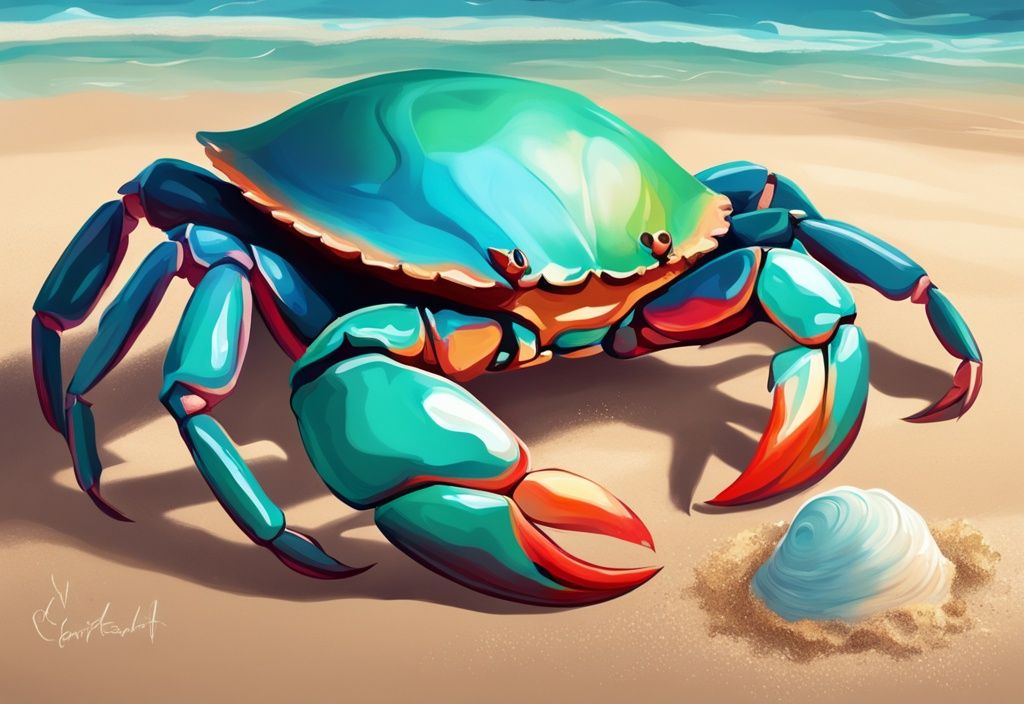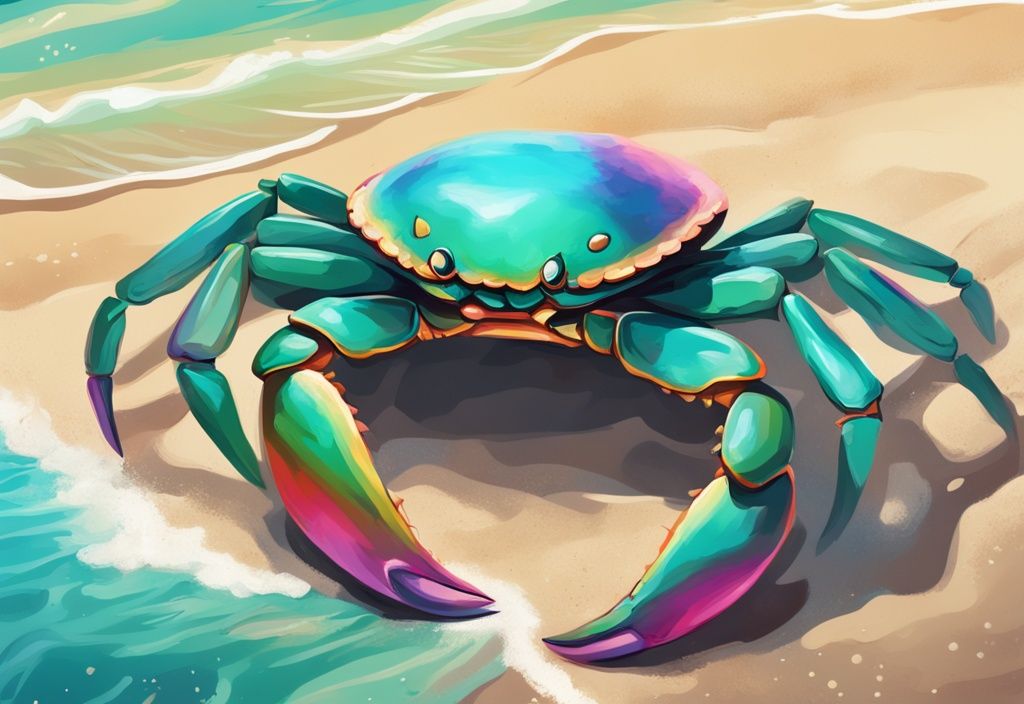Introduction to Rainbow Crabs
Rainbow Crabs, with their dazzling colors and intriguing antics, are like the Picasso of the aquatic world. Their shells, splashed with blues, reds, and purples, are not just eye-catching but a testament to nature’s artistry. Hailing from West Africa’s coastal regions, they thrive in habitats that echo their wild origins. It’s like inviting a piece of the African coast into your home!
These crabs are more than just a pretty face; their nocturnal and territorial behaviors offer a fascinating peek into crustacean life. Crafting a suitable environment goes beyond aesthetics—think of it as setting the stage for a captivating marine ballet. Join me as we explore the essentials of Rainbow Crab care, ensuring these vibrant performers remain healthy and happy in your aquarium.
Introduction to Rainbow Crabs
The Rainbow Crab, or Cardisoma armatum, is a terrestrial marvel that has captivated aquarists around the globe. Imagine a creature so vibrant and resilient that it feels like having a piece of the African coast right in your living room. This colorful crustacean, also known as the African rainbow crab, Nigerian moon crab, or Indigo crab, hails from the coastal regions of western Africa.
Why are Rainbow Crabs a hit among aquarium enthusiasts? Well, their hardy nature and straightforward care requirements make them perfect for beginners. Think of them as the adaptable adventurers of the crab world. With the right attention to their habitat and diet, these crabs can thrive in various conditions. Their unique, colorful appearance adds a splash of life to any aquarium setup, making them a fascinating and rewarding choice for both novice and seasoned aquarists.
Understanding the Natural Habitat of Rainbow Crabs
The natural habitat of Rainbow Crabs, or Cardisoma armatum, is a fascinating blend of land and water where these vibrant creatures thrive. Exploring their native regions and the environmental conditions they favor provides insight into their unique lifestyle and the challenges they face.
Native Regions and Distribution
Rainbow Crabs are native to the coastal regions of western Africa, particularly the Volta River delta. Here, the freshwater mingles with the Atlantic Ocean, creating a perfect habitat for these colorful crustaceans. They also make their homes on various islands, including Cape Verde, showcasing their remarkable adaptability. These regions offer a dynamic environment where land meets water, providing Rainbow Crabs with the resources they need to flourish.
Environmental Conditions in their Natural Habitat
The environments Rainbow Crabs inhabit are as varied as their striking colors. From lush forests to dense mangroves and expansive swamps, these areas provide a mix of terrestrial and aquatic elements crucial for their survival. Despite their adaptability, Rainbow Crabs face challenges like habitat loss and pollution. While not currently endangered, these threats highlight the importance of conservation efforts to protect their unique ecosystems. Imagine these crabs as tiny custodians of their habitats, reminding us of the delicate balance needed to maintain such vibrant ecosystems.

Physical Characteristics of Rainbow Crabs
Rainbow Crabs, or Cardisoma armatum, are captivating creatures that bring a splash of color and intrigue to any aquarium setting. This section delves into their unique features and the fascinating processes that define their lives.
Unique Coloration and Size
One of the most striking aspects of Rainbow Crabs is their vivid coloration. Imagine a carapace painted in a rich purple-blue, beautifully offset by legs that blaze in shades of orange-red. This kaleidoscope of colors not only makes them a favorite among aquarists but also adds a dynamic element to their visual appeal as they age and their hues lighten.
In terms of size, these crabs are quite manageable for home aquariums. Their carapace typically measures between 7 to 12 centimeters, which is about 3 to 3.5 inches. This size strikes a perfect balance, offering aquarists a fascinating specimen that is easy to care for and observe. If you’re curious about the dietary habits of aquatic pets, you might wonder, what do African Dwarf Frogs eat in their natural habitat.
The Fascinating Molting Process
Molting is an essential chapter in the life story of a Rainbow Crab. It’s akin to a dramatic costume change, where the crab sheds its old shell to make way for a new, larger one. This process is crucial not only for growth but also for maintaining their health.
Post-molt, these crabs have a pressing need for calcium to ensure their new shell hardens properly. This requirement highlights the importance of a calcium-rich diet and optimal environmental conditions. Supporting this natural cycle is vital for the well-being of these captivating creatures, ensuring they continue to thrive in their aquatic homes.
Behavior and Temperament of Rainbow Crabs
Their Nocturnal Lifestyle
Rainbow Crabs, celebrated for their kaleidoscope of colors, are creatures of the night. As dusk descends, these vibrant crustaceans spring into action, embarking on nightly adventures of foraging and exploration. By day, they retreat to their burrows, seeking solace and safety from potential threats. This nocturnal rhythm is a survival strategy in the wild and a crucial consideration for those setting up a home habitat. To replicate their natural environment, it’s important to provide plenty of hiding spots and keep the lighting dim. This way, these crabs can feel secure and flourish.
Aggressiveness and Territorial Nature
Rainbow Crabs are not just pretty faces; they have a feisty side, especially the males. Their territorial instincts are strong, prompting them to defend their space with vigor. In a home aquarium, this means they prefer solitude or the company of a single crab of the opposite sex to avoid skirmishes. Understanding this aggressive streak is key for aquarists aiming to create a peaceful environment. By ensuring ample space and distinct territories, you can help these crabs express their natural behaviors without stress or conflict.
Creating the Perfect Rainbow Crab Habitat at Home
A Rainbow Crab’s home is more than just a tank; it’s a miniature ecosystem that mirrors their natural environment. Let’s dive into the essentials of crafting a sanctuary that ensures their well-being and happiness.
Essential Paludarium Requirements
A well-designed paludarium is crucial for the health and happiness of your Rainbow Crab. Think of it as a cozy apartment with both land and water features. A minimum tank size of 20 gallons is recommended, providing ample space for exploration and burrowing. The land area should include sand or soil substrates, allowing the crab to dig and create burrows. Meanwhile, the aquatic section should have shallow water to accommodate their semi-aquatic lifestyle. Adding rocks, driftwood, and plants can enhance the environment, offering hiding spots and climbing opportunities—think of it as their personal jungle gym.
Maintaining Water Quality and Conditions
Rainbow Crabs are quite the divas when it comes to water quality, so maintaining optimal conditions is essential. Use dechlorinated water to prevent harmful chemicals from affecting their health. Keep the water temperature between 24-29°C, with a humidity level of 75% or higher to replicate their humid natural environment. Regular water changes and a reliable filtration system are necessary to keep the water clean and free from pollutants. Monitoring these parameters ensures a healthy habitat, reducing stress and promoting longevity.
Tips for Preventing Escapes
Rainbow Crabs are excellent climbers, making a secure tank setup vital to prevent escapes. Ensure the tank lid fits tightly and consider using clips or weights to hold it in place. Avoid placing decorations or equipment close to the tank edges, as these can be used as escape routes. Regularly inspect the tank for any gaps or weaknesses that might allow the crab to escape. By taking these precautions, you can keep your Rainbow Crab safe and contained within its habitat.
Feeding Your Rainbow Crab: Diet and Habits
Understanding their Omnivorous Diet
Rainbow Crabs are truly captivating, with their omnivorous and opportunistic feeding habits. In the wild, they enjoy a smorgasbord of fruits, vegetables, meats, and various aquatic delicacies. To ensure your Rainbow Crab thrives in captivity, it’s crucial to replicate this diverse menu. A nutritious diet should include fresh fruits and vegetables, which are packed with vital vitamins and minerals. On the protein front, think of fish pellets, shrimp, and insects as the building blocks for their growth and energy. By offering a buffet of choices, you not only cater to their nutritional needs but also encourage their natural foraging instincts, keeping them both entertained and healthy.

Foods to Avoid for Healthy Crabs
Though not particularly fussy, Rainbow Crabs do have their quirks. They are notorious for not being plant-friendly, often munching on or uprooting any greenery in sight. So, if you’re not keen on seeing your tank’s flora in disarray, it’s best to steer clear of live plants unless you’re prepared for some crab-induced chaos. When it comes to tankmates, avoid smaller invertebrates like shrimp and snails, as these might end up on the menu rather than being companions. By thoughtfully curating their diet and environment, you create a harmonious and healthy home for your Rainbow Crab.
Ensuring the Health and Longevity of Your Rainbow Crab
Rainbow Crabs are fascinating creatures that require specific care to thrive in captivity. Understanding their needs is key to promoting their health and extending their lifespan. This section delves into common health issues, tips for longevity, and the challenges of breeding these vibrant crabs.
Common Health Issues and How to Prevent Them
Rainbow Crabs, though resilient, have a delicate relationship with their environment, especially in brackish water. Imagine them as little aquatic barometers, sensitive to changes in water quality. Regularly monitoring salinity levels is like checking the weather forecast—preventing stress and potential health problems.
Calcium is their best friend, particularly after molting. Without enough calcium, their shells can become soft, leaving them as vulnerable as a knight without armor. To fortify their defenses, provide a diet rich in calcium. Think of cuttlebone or calcium supplements as their daily vitamins, essential for maintaining robust shell health and overall vitality.
Tips for Ensuring Longevity
Creating a thriving environment for your Rainbow Crab is akin to crafting a gourmet meal—it requires variety and balance. A diverse diet of fruits, vegetables, and proteins is their recipe for success. Keep an eye on water quality, as it’s the foundation of their habitat. Poor conditions are like a bad storm, leading to stress and illness.
Maintaining a clean tank with the right temperature and humidity levels is like setting the perfect climate for a tropical vacation. This ensures your Rainbow Crab enjoys a healthy, stress-free life, promoting longevity and well-being.
Challenges and Tips for Breeding Rainbow Crabs
Breeding Rainbow Crabs is a bit like orchestrating a symphony—every element must be perfectly in tune. Their specific mating and larval development needs are challenging to replicate outside their natural habitat. Imagine trying to mimic seasonal changes and create a nurturing environment for their young—it’s complex and resource-intensive.
For those daring enough to try, thorough research is your sheet music. Understanding the intricate needs of Rainbow Crabs during breeding is essential. With the right preparation, you can create a harmonious environment that supports successful breeding.
Purchasing Rainbow Crabs: What to Consider
When it comes to purchasing Rainbow Crabs, there are several key factors to keep in mind. From understanding seller guarantees to the significance of quarantine procedures, each aspect plays a crucial role in ensuring you bring home a healthy and vibrant crab.

Understanding Live Arrival Guarantee
Imagine eagerly awaiting the arrival of your new Rainbow Crab, only to find it lifeless upon delivery. This is where the live arrival guarantee becomes your safety net. Sellers often provide this assurance, promising that your crab will arrive alive and in good condition. However, there’s a catch. To claim a refund, you’ll need to snap a picture of the deceased crab while it’s still in its unopened bag. Once released into your tank, any misfortune becomes your responsibility. This policy highlights the importance of preparing your tank and acclimating your new pet properly to ensure its health and longevity.
Importance of Quarantine Procedures
Quarantine procedures are like a wellness check-up for Rainbow Crabs before they make their way to you. Upon arrival at the warehouse, these crabs undergo a one-week quarantine. This period is essential for monitoring any signs of illness or stress. It’s akin to a spa retreat, where potential health issues are identified and treated, ensuring only the healthiest crabs are available for sale. By following these procedures, sellers can provide you with robust and vibrant Rainbow Crabs, ready to thrive in their new homes.
Conclusion
Rainbow Crabs are a mesmerizing addition to any aquarium, offering a vibrant splash of color and a fascinating glimpse into the world of terrestrial crabs. Their brilliant hues and captivating behaviors make them an excellent choice for aquarists eager to diversify their tank inhabitants. However, ensuring their well-being requires a deep understanding of their specific needs and natural behaviors.
To care for Rainbow Crabs successfully, it’s crucial to replicate their natural habitat. Imagine creating a mini ecosystem—a paludarium setup that blends both land and water. This allows them to exhibit natural behaviors like burrowing and climbing. Maintaining optimal water quality and environmental conditions is vital, as these crabs are quite sensitive to changes in their surroundings. Think of it as setting the perfect stage for a delicate performance.
Feeding them is another key aspect. As omnivores, Rainbow Crabs thrive on a varied diet, enjoying a mix of fruits, vegetables, meats, and specialized crab foods. It’s like preparing a balanced meal plan for a picky eater. Avoiding certain foods and potential tankmates can prevent health issues, ensuring a harmonious environment.
By understanding and meeting these needs, aquarists can enjoy the vibrant presence of Rainbow Crabs in their tanks. This ensures these fascinating creatures lead healthy and fulfilling lives in captivity, bringing a slice of their natural world into ours.
Frequently Asked Questions about Rainbow Crabs
Rainbow Crabs, with their vibrant hues and intriguing behaviors, are a fascinating addition to any aquarium. Below, you’ll find answers to common questions about their care and habitat needs, helping you create a thriving environment for these colorful creatures.
What is the Ideal Tank Size for a Rainbow Crab?
Think of a Rainbow Crab’s tank as its miniature kingdom. A minimum of 20 gallons is essential to provide them with ample space to roam and explore. This size helps replicate the terrestrial and aquatic elements of their natural habitat, ensuring they feel right at home.
Can Rainbow Crabs Coexist with Other Tankmates?
Rainbow Crabs have a bit of a lone wolf personality. They’re territorial and can be quite the grump, especially males. It’s best to house them alone or with just one crab of the opposite sex. Avoid pairing them with smaller invertebrates like shrimp and snails, as these might end up as unintended snacks.
How Often Should I Feed My Rainbow Crab?
Feeding a Rainbow Crab is like preparing a gourmet meal for a tiny, colorful guest. They thrive on a varied diet, so mix it up with fruits, vegetables, meats, and fish pellets. This diverse menu ensures they get all the nutrients needed for a vibrant and healthy life.
What to Do If Your Rainbow Crab Escapes?
Rainbow Crabs are curious little escape artists. Make sure your tank is secure to prevent their great escape. If one does manage to wander off, don’t panic. They usually stick close to their habitat, so check nearby areas. It’s like playing a game of hide and seek, but with a crustacean twist!
